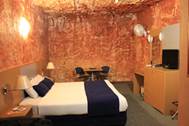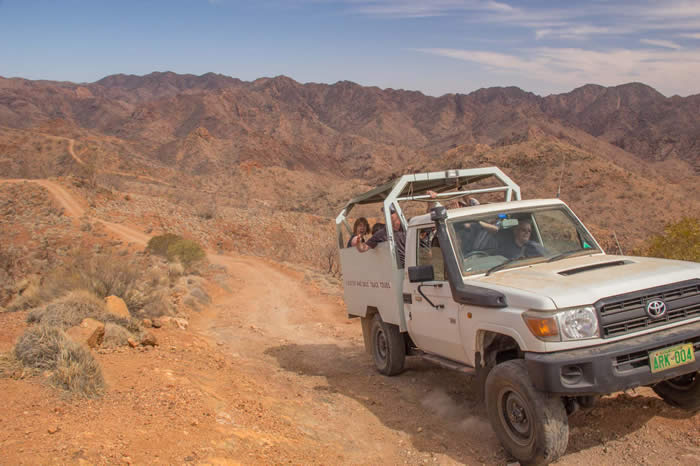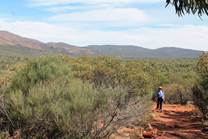




|
|
|
we accept |
|
proud member of  |
|
proud member of  |
|
proud member of  |
|
proud member of  |
|
|
13 Day Outback South Australia 4WD Tour
You will be collected from your Adelaide accommodation at 7am this morning for your private 13 day 4WD Safari through the South Australian Outback including the Oodnadatta, Birdsville and Strzelecki tracks. Our destination today is the opal capital of the world, Coober Pedy and it will take us all day to get here. Coober Pedy is as famous for it’s underground homes as it is for it’s opals and 50% of the population live underground (in homes called “dugouts”), as well as using underground shops and churches. Upon arrival into Coober Pedy, we check into our hotel and then enjoy our first dinner together as a group, in the restaurant. Overnight accommodation- underground motel room with en-suite, Coober Pedy (2 night stay) **above ground rooms are also available, if preferred** Day 2 (B,L,D) There’s some free time this morning for you to have a wander through the town, visit the Old Timers Mine and Museum, The Umoona opal mine and museum (also home to the “Footsteps in time” fossil display), visit one of the underground churches in the town or have a look around Crocodile Harry's Underground Nest, one of the weirdest dugouts of Coober Pedy and one of most famous in the world due to it’s use in the movie Mad Max Beyond the Thunderdome. After lunch we take a guided tour through a working Opal Mine, where we get an insight of what it means to be an Opal Miner. Late this afternoon, we make our way out of town to the nearby Breakaways Reserve, offering a striking & unique example of arid scenery. From the flat - topped mesas to the stony gibber desert, remnants of millions of years provide a weal Overnight accommodation- underground motel room with en-suite, Coober Pedy Day 3 (B,L,D) This morning we depart Coober Pedy early and head across the Moon Plain to the Painted Desert (Arckaringa Hills). The Moon Plain is rich in fossil deposits, evidence of the inland sea that covered this region 120 million years ago and offers a vast expanse of rocky plains unlike anywhere else. The strange lunar landscape has been used for many Hollywood movies inc We’ll cross the Dog Fence numerous times during the trip but the first time is today on the way to the Breakaways. The longest fence in the world, at 5300km’s, it stretches across 3 states, from Queensland to the far west of South Australia. The Painted Desert is an ancient Inland Sea bed where the hills are the result of rain, weather and erosion. The slopes and shapes include many different colours and shades of orange, yellow and white- hence the name “Painted Desert”. After viewing and photographing the Painted Desert from the lookout, we continue through to Oodnadatta. Famous for it’s pink roadhouse, the town was originally created when the Overland Telegraph Line was laid and then became the northern terminus for the Central Australia Railway. After lunch we join the 615km unsealed Oodnadatta Track, which follows the Old Ghan Railway line and the Overland Telegraph, after it was originally mapped by the explorer, John McDouall Stuart. The track follows an old Aboriginal trading route through semi-desert country with artesian springs and waterholes along the way. The route was also used by camel trains in the 1880’s, led by cameleers from Afghanistan, both of whom were especially brought to Australia for the task of hauling goods into Central Australia for use by pioneer settlers. Camels were the only pack animals capable of taking on a six-week journey in often extreme heat, through sandy terrain. When the train line was extended to Alice Springs in 1929, many of these camels were left to run wild in the outback where they number in the tens of thousands today. The line became known as the Central Australian Railway and the train service on the line was known as the Ghan in honour of the Afghan cameleers. The Oodnadatta Track is littered with ruins of old town sites, station ruins, homes, cairns We arrive at William Creek, the smallest settlement in South Australia with a population of 3 humans and a dog ! It’s located 165km’s from the nearest town and sits in the largest cattle station in the world (Anna Creek-approximately the size of England). Overnight accommodation - motel room with en-suite, William Creek Pub Hotel, middle of nowhere, Outback South Australia Day 4 (B,L,D) There's time for optional scenic flights over Lake Eyre this morning (additional cost). Departing William Creek, we make our way out to Halligan Bay at Lake Eyre North for a look at the magnificent l We continue exploring the Oodnadatta Track this morning, heading south towards Marree. We stop several times en-route, including the natural artesian springs within Wabma Kadarbu Mound Springs Conservation Park. The Blanche Cup and The Bubbler mound springs are created from water deep within the Great Artesian Basin which filters to the surface forming mounds and bubbling ponds. After stopping at the Lake Eyre South lookout, we pass the famous dingo fence again and then reach Marree, which is situated at the crossroads of the Oodnadatta and Birdsville Tracks. The town also has a rich Aboriginal, Afghan and European heritage. Overnight accommodation – motel room with en-suite, Marree Pub Hotel Day 5 (B,L,D) Departing Marree, we now travel north on the famous stock route, which is the Birdsville Track. The track passes through the Tirari and Sturt Stony Deserts and is extremely remote but strikingly beautiful in its harshness. The 517km track, which traverses vast gibber strewn plains and sand dunes, was established in the 1860s as the main stock route to bring cattle from central Queensland to the railway in Marree. In these days the track had a grim reputation, man We have a look at the ruins of the Lake Harry Date Plantation and then stop at the Cooper Creek Crossing, before driving through the Natterannie Sandhills and Mungerannie Gap, which is the largest geographical sight along the Birdsville Track (150m).We pass Mirra Mitta Bore, a hot flowing artesian bore, and the last leg of the track, into Birdsville, takes us past Koonchera Dune.Crossing into Queensland, we arrive into Birdsville and check into our accommodation Overnight accommodation- motel room with en-suite, Birdsville Pub Hotel (2 night stay) Day 6 (B,L,D) There’s some free time this morning for you to have a wander through the town- perhaps visit the Birdsville Workingmuseum, one of the art galleries, go for a swim or bird watch at the Birdsville Billabong, enjoy the delights of the famous Birdsville Bakery or visit the frontier Australian Inland Mission Hospital Museum. Late this afternoon, you’ll take a locally run tour around the town and then out to “Big Red”, the largest and most famous sand dune in the Simpson Desert. It offers fantastic photo opportunities, especially at sunset. Overnight accommodation- motel room with en-suite, Birdsville Pub Hotel Day 7 (B,L,D) We head south again today, through Cattle Country and back into South Australia to Innamincka, made famousby Victorian explorers Burke and Wills and their ill-fated exploration across central Australia. En-route we enjoy the view at Deon's Lookout and visit The Dreamtime Serpent – a work of art representing a series of pathways travelled through Country to connect the river systems in the Channel Country of the Diamantina Shire. The Serpent has been created using gravel and gibbers found throughout the shire. We continue to the tiny outback town of Innamincka, situated in the heart of the Regional Reserve, covering over 1.3 million hectares of land ranging from expanses of gibber rises to the thriving wetlands of the Cooper Creek system. The Cooper Creek is Australia’s 2nd longest inland river system (after the Murray Darling) and was a major Aboriginal trade route. Overnight accommodation- motel room with en-suite, Innamincka Pub Hotel (2 night stay) Day 8 (B,L,D) This morning we visit the famous Burke and Wills Dig Tree (camp LXV). It was here that the explorers left a base camp while they continued north, along with King and Grey. In charge of the camp, Brahe waited longer than he’d been requested to but h Other options today, depending on conditions and everyones preferences, are to visit Burkes Grave, Wills Grave, Kings Marker or one of the local waterholes. When water levels are high enough, the hotel alos runs a cruise on Cooper Creek. Overnight accommodation- motel room with en-suite, Innamincka Pub Hotel Day 9 (B,L,D) We depart Innamincka this morning and head south through the Strzelecki Desert and join the last of our legendary Outback Tracks- the Strzelecki Track. Explorer Charles Sturt named the track after Polish explorer and geologist Paul Edmund de Strzelecki and the 465km track runs north <>south from Lyndhurst to Innamincka. The Track was pioneered as a cattle route by bushman Harry Redford (AKA Captain Starlight), who brought 1000 stolen cattle from Queensland to South Australia in 1871 without a single death. Although caught with conclusive evidence, the j Our first stop today is the viewpoint at the Moomba oil and gasfields. Natural gas was first discovered in the region in 1966 and was followed by the discovery of oil in 1970. Moomba is now a major supplier of both for Australian and overseas markets. We continue down the Strzelecki Track and turn off towards the Northern Flinders Ranges, heading towards Arkaroola Wilderness Sanctuary. The privately owned sanctuary was founded in 1969 by Reg Sprigg, Biologist, Oceanographer, Conservationist, scientist and pioneer of eco-tourism. Many minerals are found on Arkaroola, including gold, sapphires, rubies, amethyst, several forms of quartz, uraninite and malachite (among others) and evidence of early mining is scattered about Arkaroola and the Gammon Ranges. Arkaroola is also famous for it's clear night skies and offers some of the best viewing conditions in Australia. Overnight accommodation- motel room with en-suite, Arkaroola Wilderness Sanctuary (2 night stay) Day 10 (B,L,D) This morning you’ll take Arkaroola’s famous Ridgetop tour- an unforgettable encounter with the timeless terrain and unique natural beauty of Arkaroola Wilderness Sanctuary. Learn from your Arkaroola guides about Arkaroolas 1600 million year old geological history as they navigate the steep slopes and hair raising ascents of the Ridgetop Track. Inspiring images of red granite mountains and golden spinifex covered hillsides This afternoon is free for you to take one of the local bushwalks, go bird watching (there are over 160 recorded bird species in the Arkaroola area as well as an abundance of native flora and fauna), take a scenic flight or take a tour of an astronomical observatory (the Sanctuary has 3 !). We are happy to pre-book these tours for you or they can be booked on arrival and optional tours are at own expense. Overnight accommodation- motel room with en-suite, Arkaroola Wilderness Sanctuary Day 11 (B,L,D) Departing Arkaroola, we make our way south on a lovely drive to the historic town of Blinman, the highest town in South Australia sitting at 614m above sea level. Copper was found in the area in 1859 by a 1 legged shepherd called Robert “Peg Leg” and the town boomed over the nextdecade as miners flocked to the area. At the peak of its operation Blinman township had a population of approximately 1500. Today Blinman has a permanent population of just 22, plus the residents of the surrounding pastoral properties. After lunch we take the Blinman Mine Experience, which takes us back in tim After the mine tour we venture into the central Flinders Ranges, known for their unique beauty, indigenous history, ancient geological formations, rich colours and textures and abundant wildlife. The Flinders Ranges are home to a huge array of plant species, birds, reptiles and mammals and the vibrant colours of the 800 million-year-old quartzite and limestone outcrop that is the Flinders, are truly spectacular. We continue through Parachilna Gorge to Parachilna, another tiny township with a population in single digits ! It’s a favourite among film makers thanks to the beautiful landscape. Overnight accommodation- motel room with en-suite, Prairie Hotel in Parachilna Day 12 (B,L,D) This morning we take the Brachina Gorge Geological Trail, a trail that passes through 130 million years of earth history, including meteorite debris, stromatolites and fossilized plant and animal life. It offers an insight into past climates, the formation of the ranges and the evolution of early forms of life. It’s also an important refuge for the rare and endangered Yellow-footed Rock-wallaby. We travel through th We stop for photos at Cazneaux's tree, before continuing to Wilpena Pound, where you have the option of taking a walk into Wilpena Pound or take a scenic flight (at own expense). Walk along the beautiful Wilpena Creek, framed by huge river red gums, into Wilpena Pound. Walking on to the Old Hills Homestead, you can learn about the hardships the Hills family had to face at the turn of the century with the option of walking up to the Wangara lookout to see the mystical heart of the Flinders Ranges with stunning views over Wilpena Pound. There is a shuttle available to shorten the walk. Our final dinner as a group will be served in the restaurant at Wilpena Pound Resort, our accommodation for this evening. Overnight accommodation- Wilpena Pound Resort- standard room with en-suite Day 13 (B,L)
We continue to Quorn, home to the famous Pichi Richi Railway and many heritage buildings. The Quandong Café is located in the oldest stone building in Quorn, at 130 years old and is home to the famous Quondong Pie. The last leg of our journey takes us back onto the highway and from here we continue south to Adelaide We arrive in Adelaide at approximately 6pm and you will be dropped off at your accommodation
END ITINERARY B = Breakfast / L = Lunch / D = Dinner This tour is operated as a private tour only (sole use of tour vehicle and driver guide) and can depart on any day, subject to availability and weather and road conditions, between September and April inclusive. The itinerary can be amended to suit your requirements, so please contact us for more information or a quote. Click here for our scheduled tour itineraries Inclusions: • Sole use of 4WD tour vehicle with professional driver guide • Permits and entry fees • Big Red sunset tour • Opal mine tour at Coober Pedy • Arkaroola Ridgetop tour • Mine tour in Blinman Exclusions: • Pre & Post tour accommodation • Arrival / departure flights • Optional extra activities such as Lake Eyre scenic flight Testimonial : My tour was all i expected and more. The tour vehicle was very comfortable and clean, meals were all great and i was happy with the accommodation, being pleasantly surprised at a couple of places. Dave was excellent- he is good with people and has a wealth of knowledge, some fantastic stories and some fantastic "tales" as well. He mad the history of the land interesting. I learned a lot and saw some amazing places and sights. I loved every minute of the trip and would do it again in a heartbeat. Thank you too Danielle, as i know there is a fair bit of planning for thses type of trips. Cheryl, travelled Oct 2019 |




